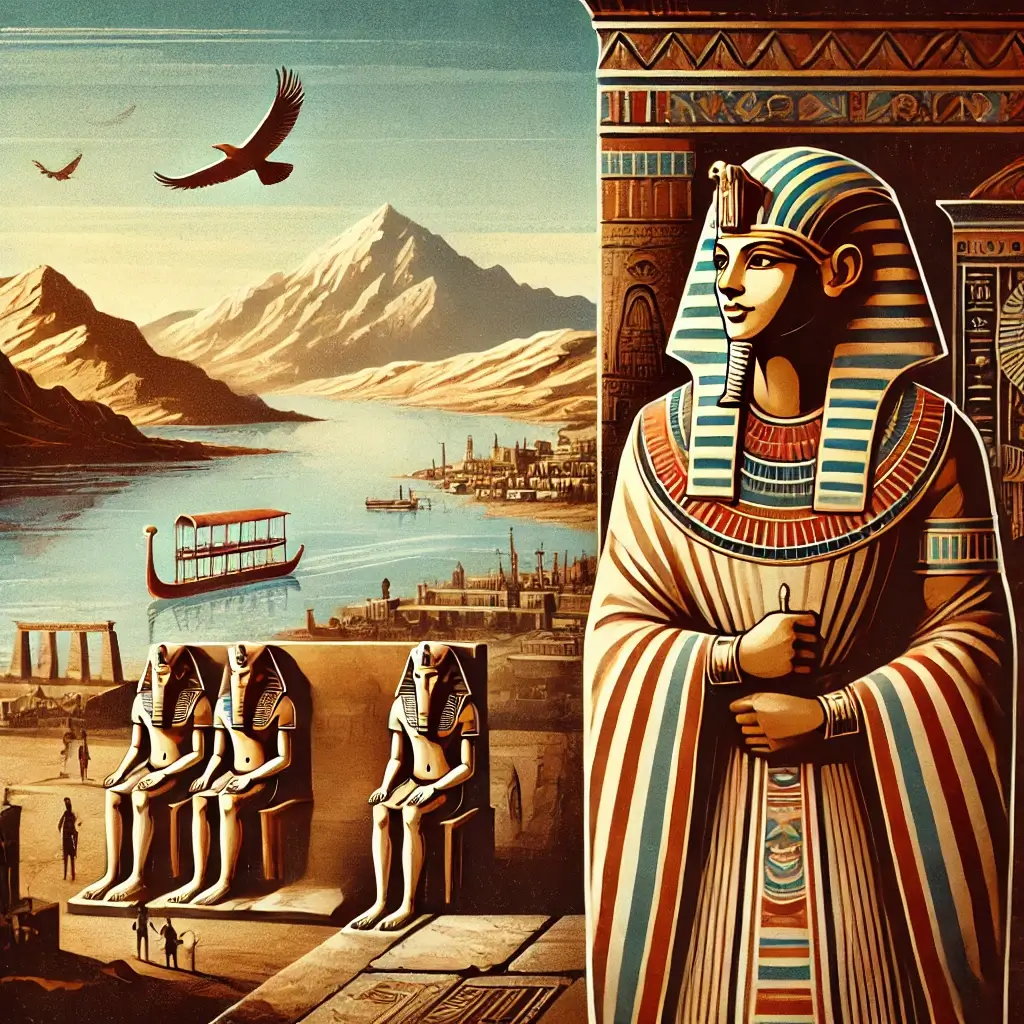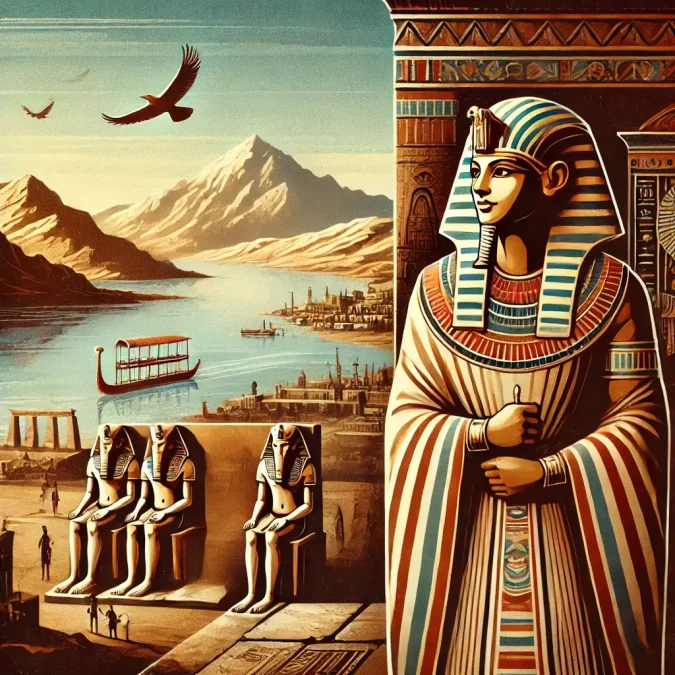
The Eleventh Dynasty of ancient Egypt (c. 2150 BC – c. 1991 BC), also known as Dynasty XI, played a crucial role in the transition from the chaos of the First Intermediate Period to the stability and prosperity of the Middle Kingdom. The early members of the Eleventh Dynasty are often grouped with the four preceding dynasties as part of the First Intermediate Period, a time characterized by political fragmentation, regional rivalries, and social upheaval. However, the later rulers of the Eleventh Dynasty, particularly Pharaoh Mentuhotep II, succeeded in reuniting Egypt and laying the foundation for the Middle Kingdom.
The Eleventh Dynasty ruled from Thebes in Upper Egypt and marked a significant shift in political power away from the traditional capital of Memphis. This dynasty is notable for its efforts to reunify Egypt, restore central authority, and establish a new era of cultural and economic growth. In this article, we will explore the history, rulers, cultural achievements, and challenges faced by the Eleventh Dynasty, along with the contributions of each pharaoh and their impact on ancient Egyptian civilization.
The Historical Context of the Eleventh Dynasty
The First Intermediate Period: A Time of Division and Struggle
The First Intermediate Period of ancient Egypt was a time of political fragmentation and instability, following the decline of the Old Kingdom. The collapse of centralized governance at the end of the Sixth Dynasty led to the rise of regional power centers, with local leaders and nomarchs gaining increasing authority over their territories. This period of disunity is often described as a “dark age” in Egyptian history, characterized by a lack of strong central leadership, economic challenges, and social upheaval.
The Eleventh Dynasty emerged in this context of political fragmentation, following the Tenth Dynasty, which was based in Herakleopolis. The early rulers of the Eleventh Dynasty were initially regional leaders based in Thebes, who sought to extend their influence over Upper Egypt. The rivalry between Thebes and Herakleopolis defined the political landscape of the early Eleventh Dynasty, as both regions competed for control over Egypt. The eventual victory of the Theban rulers would lead to the reunification of the country and the establishment of the Middle Kingdom.
The Rise of Thebes
Thebes, known as Waset in ancient Egyptian, became the seat of power for the rulers of the Eleventh Dynasty. Located in Upper Egypt, Thebes played a crucial role in the political landscape of the First Intermediate Period. The rulers of Thebes sought to establish their dominance over Egypt and challenge the authority of the Herakleopolitan rulers in Lower Egypt. The ongoing conflict between Thebes and Herakleopolis eventually led to the reunification of Egypt under the leadership of Mentuhotep II, marking the beginning of the Middle Kingdom.
The Rulers of the Eleventh Dynasty
The Eleventh Dynasty of Egypt is known for its rulers, who played a crucial role in shaping the history of the First Intermediate Period and the Middle Kingdom. The following section provides a summary of the key rulers of the Eleventh Dynasty and their contributions to Egyptian history.
King Mentuhotep I
Mentuhotep I is traditionally considered the founder of the Eleventh Dynasty. He was a local ruler in Thebes who began to establish his authority in Upper Egypt. Mentuhotep I’s reign marked the beginning of Theban efforts to extend their influence over the surrounding regions. Although little is known about his reign, Mentuhotep I is credited with laying the foundation for the future successes of the Eleventh Dynasty. His efforts to consolidate power in Thebes set the stage for the reunification of Egypt under his successors.
King Intef I
Intef I, the successor of Mentuhotep I, continued the efforts to expand Theban influence in Upper Egypt. He is often regarded as the first ruler of the Eleventh Dynasty to adopt the title of “King of Upper and Lower Egypt,” signaling his ambition to reunite the country. Intef I’s reign was marked by military campaigns against rival nomarchs and regional leaders, particularly those based in Herakleopolis. His efforts to extend Theban control over Upper Egypt laid the groundwork for the eventual reunification of Egypt.
King Intef II
Intef II, the successor of Intef I, is known for his successful military campaigns and efforts to expand Theban influence. He ruled for over fifty years, and his reign was marked by significant territorial expansion and consolidation of power in Upper Egypt. Intef II continued the conflict with the Herakleopolitan rulers, seeking to establish Theban dominance over all of Egypt. He also undertook building projects in Thebes, including the construction of temples dedicated to local deities, which helped to strengthen the religious and political importance of Thebes.
King Intef III
Intef III, the successor of Intef II, continued the efforts to extend Theban influence and prepare for the eventual reunification of Egypt. His reign was relatively short, but he played a crucial role in maintaining the gains made by his predecessors. Intef III’s efforts to strengthen Theban control over Upper Egypt and his preparations for future military campaigns against Herakleopolis set the stage for the reunification of Egypt under his successor, Mentuhotep II.
King Mentuhotep II
Mentuhotep II is perhaps the most famous ruler of the Eleventh Dynasty and is credited with reunifying Egypt, bringing an end to the First Intermediate Period, and establishing the Middle Kingdom. Mentuhotep II’s reign was marked by a series of military campaigns against the Herakleopolitan rulers, culminating in the defeat of Herakleopolis and the reunification of Egypt under Theban rule. Mentuhotep II adopted the title of “Uniter of the Two Lands,” reflecting his achievement in restoring central authority and reestablishing the unity of Egypt.
Mentuhotep II also undertook significant building projects, including the construction of his mortuary complex at Deir el-Bahari, which served as a model for later pharaonic architecture. His reign marked the beginning of a new era of cultural and economic prosperity, as he worked to restore order, rebuild the economy, and promote the arts. Mentuhotep II’s successful reunification of Egypt and his efforts to restore central authority laid the foundation for the Middle Kingdom, one of the most prosperous periods in Egyptian history.
King Mentuhotep III
Mentuhotep III, the successor of Mentuhotep II, continued the work of his predecessor in maintaining the stability and prosperity of Egypt. His reign was marked by significant achievements in trade and exploration, including an expedition to Punt, a region known for its valuable resources such as incense and myrrh. Mentuhotep III also undertook building projects, including the construction of temples and infrastructure to support the growing economy. His reign was relatively peaceful, and he worked to consolidate the gains made by his father and ensure the continued prosperity of the Middle Kingdom.
King Mentuhotep IV
Mentuhotep IV was the last ruler of the Eleventh Dynasty, and his reign is relatively obscure compared to his predecessors. There is evidence to suggest that his reign may have been marked by internal challenges and a lack of strong central authority. Mentuhotep IV’s reign came to an end with the rise of Amenemhat I, who founded the Twelfth Dynasty and continued the work of consolidating central authority and building the Middle Kingdom. Despite the challenges of his reign, Mentuhotep IV played a role in maintaining the stability of Egypt during a time of transition.
Cultural and Political Achievements of the Eleventh Dynasty
The Reunification of Egypt
One of the most significant achievements of the Eleventh Dynasty was the reunification of Egypt under Mentuhotep II. The reunification brought an end to the political fragmentation and instability of the First Intermediate Period and marked the beginning of the Middle Kingdom. Mentuhotep II’s military campaigns against the Herakleopolitan rulers were instrumental in restoring central authority and reestablishing the unity of Egypt. The reunification of Egypt under Theban rule laid the foundation for a new era of cultural and economic prosperity.
The Rise of Thebes as a Political and Religious Center
The Eleventh Dynasty marked a shift in political power from Memphis, the traditional capital of the Old Kingdom, to Thebes in Upper Egypt. The rise of Thebes as the capital of Egypt was significant, as it became not only the political center of the country but also a major religious center. The rulers of the Eleventh Dynasty undertook building projects in Thebes, including the construction of temples dedicated to local deities such as Amun. The rise of Thebes as a religious center would continue to shape Egyptian history throughout the Middle and New Kingdoms.
Architectural and Cultural Developments
The Eleventh Dynasty is also notable for its architectural and cultural achievements. Mentuhotep II’s mortuary complex at Deir el-Bahari is one of the most famous architectural projects of the Eleventh Dynasty. The complex, which was built on the west bank of the Nile near Thebes, served as a model for later pharaonic architecture, including the mortuary temples of the New Kingdom. The architectural innovations of the Eleventh Dynasty reflect the renewed emphasis on monumental construction and the desire to glorify the achievements of the pharaohs.
The Eleventh Dynasty also saw a revival of art, literature, and religious practices that had declined during the First Intermediate Period. The rulers of the Eleventh Dynasty worked to promote the arts and restore the cultural heritage of Egypt. The renewed emphasis on literature, including wisdom texts and religious hymns, reflects the desire of the Theban rulers to reestablish cultural continuity and promote the values of the Middle Kingdom.
The Role of the Pharaoh and Central Authority
The Eleventh Dynasty played a crucial role in redefining the role of the pharaoh and restoring central authority in Egypt. During the First Intermediate Period, the power of the pharaoh had diminished, and regional leaders had asserted their independence. The reunification of Egypt under Mentuhotep II marked the restoration of the pharaoh’s role as the central authority and the divine ruler of the country. The rulers of the Eleventh Dynasty worked to strengthen the central government, rebuild the economy, and promote the welfare of the people.
The Transition to the Middle Kingdom
The Eleventh Dynasty marks an important transition in Egyptian history, as it set the stage for the Middle Kingdom, one of the most prosperous periods in Egyptian history. The reunification of Egypt, the restoration of central authority, and the promotion of cultural and economic growth laid the foundation for the achievements of the Twelfth Dynasty and the continued prosperity of the Middle Kingdom. The legacy of the Eleventh Dynasty is evident in the cultural, political, and architectural achievements that defined the Middle Kingdom and shaped the future of ancient Egypt.
Conclusion
The Eleventh Dynasty of ancient Egypt was a period of significant change, marking the transition from the political fragmentation of the First Intermediate Period to the stability and prosperity of the Middle Kingdom. The pharaohs of the Eleventh Dynasty, from Mentuhotep I to Mentuhotep IV, played a crucial role in shaping the history of Egypt, with Mentuhotep II achieving the reunification of the country and establishing a new era of central authority and cultural growth.
The rise of Thebes as the political and religious center of Egypt, the architectural achievements of the Eleventh Dynasty, and the restoration of central authority under Mentuhotep II laid the foundation for the Middle Kingdom, a time of renewed cultural and economic prosperity. The legacy of the Eleventh Dynasty is evident in the enduring cultural and social changes that took place during this period, as Egypt emerged from the challenges of the First Intermediate Period and entered a new era of stability and growth.
